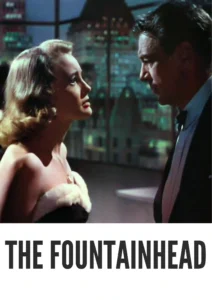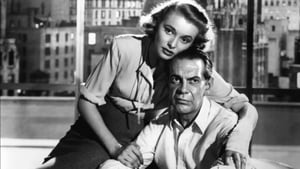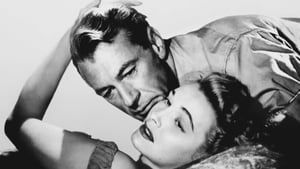Contact: info@alwanfilm.com
Video Sources 0 Views

Synopsis
The Fountainhead 1949 Colorized Review: A Provocative Adaptation of Ayn Rand’s Vision

Introduction
In the realm of film adaptations, few have sparked as much discussion and controversy as The Fountainhead (1949). Directed by King Vidor and based on Ayn Rand’s seminal novel of the same name, this film delves deep into the philosophy of individualism and the struggles of an uncompromising architect, Howard Roark. Featuring a powerful performance by Gary Cooper as Roark and a dynamic supporting cast that includes Patricia Neal and Raymond Massey, The Fountainhead presents a bold exploration of artistic integrity, societal norms, and the price of greatness. This article will examine the film’s impact, analyze its themes, and discuss its significance in the context of both cinema and philosophy.
Check The Full Colorized Movies List
Check Our Colorized Movies Trailer Channel
Understanding The Fountainhead 1949 Colorized: Director, Cast, and Genre
Director’s Vision
King Vidor, a notable figure in Hollywood’s Golden Age, directed The Fountainhead with a vision that aimed to stay true to Rand’s original philosophy. Vidor was known for his ability to marry strong narratives with stunning visuals, and in The Fountainhead, he effectively translated Rand’s complex themes into a cinematic language. His direction allows the film to explore profound ideas while still engaging audiences with dynamic performances and striking visual compositions.
The film’s aesthetic reflects Vidor’s commitment to showcasing the architectural beauty that is central to the story. The cinematography captures the grandeur and starkness of the modernist buildings that symbolize Roark’s vision, reinforcing the narrative’s thematic focus on the conflict between individualism and collectivism.
The Iconic Performance of Actors
Gary Cooper’s portrayal of Howard Roark is one of the film’s most lauded aspects. Cooper embodies Roark’s relentless spirit and unwavering dedication to his principles, delivering a performance that resonates with both strength and vulnerability. His ability to convey Roark’s inner turmoil, coupled with his physicality, creates a compelling character who stands firmly against the societal pressures surrounding him.
Patricia Neal plays Dominique Francon, a complex character who both admires and fears Roark. Neal’s performance adds emotional depth to the film, as her character struggles with her own beliefs about love, art, and society. Raymond Massey delivers a strong performance as Gail Wynand, the powerful newspaper tycoon who represents the forces of conformity and compromise that Roark resists.
Exploring the Genre
The Fountainhead (1949) is a unique blend of drama and philosophical exploration, often categorized within the broader genre of romanticism. Unlike typical romantic dramas, it places a significant emphasis on the conflict between the individual and society, making it more of a philosophical treatise than a conventional love story. The film’s focus on architecture as a metaphor for human creativity and integrity adds layers to its classification, positioning it as a notable entry in the canon of American cinema that challenges viewers to reconsider their understanding of art, individuality, and success.
Exploring the World of The Fountainhead 1949 Colorized: Plot and Characters
Detailed Synopsis
The Fountainhead follows the journey of Howard Roark, an innovative architect who refuses to conform to traditional architectural styles. After being expelled from architectural school for his radical ideas, Roark struggles to find work in a world that values conformity over creativity. His uncompromising nature leads him to reject numerous job offers that would require him to compromise his vision.
As Roark begins to establish himself, he encounters Dominique Francon, a passionate writer and critic who becomes enamored with his ideals. However, Dominique is torn between her admiration for Roark and her fear of a world that would stifle his genius. The film explores their tumultuous relationship as Dominique grapples with her conflicting desires.
The narrative also includes Gail Wynand, a powerful media mogul who recognizes Roark’s talent but is ultimately driven by his own ambitions and the desire for societal approval. Wynand’s relationship with Roark highlights the film’s central conflict between individual integrity and the pressures of conformity.
The Complex Protagonist and Memorable Supporting Characters
Howard Roark is a richly complex character, representing the archetype of the misunderstood genius. His relentless pursuit of artistic integrity serves as a powerful commentary on the sacrifices that true creators must make. The supporting characters—Dominique Francon and Gail Wynand—each embody different aspects of the struggle between individualism and societal expectations. Dominique’s internal conflict mirrors Roark’s struggle, while Wynand’s character serves as a cautionary tale of what happens when one compromises their principles for power.
The Philosophy of Ayn Rand: Individualism and Objectivism
Exploring Rand’s Ideology
Ayn Rand’s philosophy, known as Objectivism, is a central theme in The Fountainhead. Objectivism champions individualism, asserting that each person’s life and happiness are the ultimate values. Rand’s work emphasizes the importance of pursuing one’s own happiness and the necessity of self-reliance. In the context of The Fountainhead, Roark’s journey epitomizes these ideals, as he refuses to conform to societal pressures and remains true to his vision, regardless of the consequences.
The Impact of Rand’s Philosophy on Cinema
Rand’s ideology has had a lasting impact on both literature and film, influencing generations of artists and thinkers. The film adaptation of The Fountainhead serves as a vehicle for Rand’s ideas, sparking discussions about the role of the individual in society and the moral implications of artistic expression. The film’s release during the post-World War II era, a time when American society was grappling with issues of conformity and individual rights, made its themes particularly resonant.
The Art of Film Adaptation
Challenges of Adapting Ayn Rand’s Novel
Adapting a complex philosophical novel like The Fountainhead into a feature film poses significant challenges. The film must balance Rand’s intricate ideas with engaging storytelling, ensuring that the audience can grasp the themes without losing interest. Vidor faced the task of condensing Rand’s narrative while maintaining the essence of her philosophy.
One of the key challenges was translating Roark’s architectural vision into a visual medium. The film uses architectural design as a central metaphor, showcasing Roark’s buildings as embodiments of his ideals. Vidor’s careful attention to the visual representation of architecture helps ground the philosophical discussions in a tangible context, allowing viewers to engage with the story on multiple levels.
The Role of Cinematic Language
The cinematography in The Fountainhead plays a crucial role in conveying its themes. The film’s visual style reflects the stark contrasts between Roark’s modernist designs and the more traditional styles represented by his rivals. Vidor employs sweeping camera movements and striking compositions to emphasize the grandeur of Roark’s work, reinforcing the idea that true art transcends societal conventions.
The use of light and shadow also enhances the film’s emotional depth. The interplay between light and darkness serves as a metaphor for the struggle between individualism and collectivism, highlighting Roark’s journey as he navigates a world that often seeks to suppress his vision.
Reception and Controversy Surrounding The Fountainhead 1949 Colorized
Initial Reviews and Audience Reactions
Upon its release, The Fountainhead (1949) elicited a mixed response from critics and audiences alike. While some praised the film for its bold themes and strong performances, others criticized its heavy-handed approach to Rand’s philosophy. The film’s exploration of individualism resonated with many viewers, but others found it too didactic and lacking in emotional nuance.
Despite the polarized reception, The Fountainhead developed a cult following over the years. Its provocative themes and strong performances, particularly by Cooper and Neal, continue to attract audiences interested in exploring the intersection of art and philosophy. The film’s legacy endures as a thought-provoking exploration of individualism and artistic integrity.
Controversy Surrounding Rand’s Philosophy
The film’s association with Ayn Rand and her controversial philosophy has sparked ongoing debates about its moral implications. Critics argue that Rand’s Objectivism promotes selfishness and a disregard for social responsibility, while supporters contend that it advocates for personal freedom and creativity. These discussions reflect broader societal tensions regarding the role of the individual within the collective, making The Fountainhead a relevant topic for contemporary audiences.
Influence and Legacy: The Fountainhead 1949 Colorized’s Impact on Cinema
Lasting Impact on Filmmaking
The Fountainhead (1949) has left an indelible mark on the landscape of American cinema. Its exploration of philosophical themes paved the way for future filmmakers to tackle complex ideas within a narrative framework. The film’s focus on the struggles of the individual artist has influenced a range of films across genres, encouraging filmmakers to engage with themes of integrity, creativity, and societal pressure.
In the decades since its release, The Fountainhead has inspired numerous discussions and analyses, solidifying its place as a significant cultural artifact. Its continued relevance speaks to the enduring power of Rand’s ideas and the universal struggles faced by artists striving for authenticity in a conformist society.
Where to Watch The Fountainhead 1949 Colorized Online
For those interested in experiencing The Fountainhead (1949), the film is available for streaming on various platforms, including Amazon Prime Video and Turner Classic Movies. DVD and Blu-ray editions of the film, often featuring additional commentary and bonus materials, can also be found for those who wish to explore its themes in greater depth.
FAQs About The Fountainhead 1949 Colorized
Q: What is the significance of The Fountainhead (1949) in cinema?
A: The Fountainhead is significant for its exploration of individualism and artistic integrity, embodying Ayn Rand’s Objectivist philosophy. Its themes continue to resonate with audiences and influence filmmakers today.
Q: Who directed The Fountainhead (1949)?
A: The Fountainhead was directed by King Vidor, a prominent filmmaker known for his ability to blend strong narratives with compelling visual storytelling.
Q: How does the film adapt Ayn Rand’s novel?
A: The film condenses the complex themes and narrative of Rand’s novel into a cinematic format, using visual language and character interactions to convey her philosophy of individualism and integrity.
Q: What are the main themes explored in The Fountainhead (1949)?
A: The film explores themes of individualism, artistic integrity, societal pressure, and the moral implications of personal ambition, reflecting Rand’s Objectivist philosophy.
Q: How has The Fountainhead (1949) influenced modern cinema?
A: The film has inspired filmmakers to engage with philosophical themes and the struggles of the individual artist, shaping the narrative landscape of American cinema.
Conclusion
The Fountainhead (1949) remains a provocative and thought-provoking film that continues to challenge audiences to consider the value of individualism and artistic integrity. King Vidor’s direction and Gary Cooper’s powerful performance create a cinematic experience that resonates with viewers, inviting them to explore the complexities of human creativity and the societal forces that seek to suppress it. The film’s legacy endures, sparking discussions about the role of the individual in society and the moral implications of pursuing one’s vision against all odds. Whether viewed for its philosophical insights or its cinematic artistry, The Fountainhead remains a compelling exploration of the eternal struggle between the individual and the collective.













